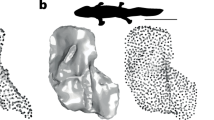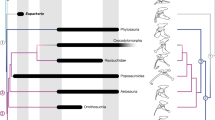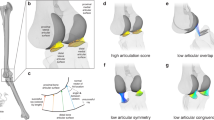Abstract
The origin of tetrapods and the transition from swimming to walking was a pivotal step in the evolution and diversification of terrestrial vertebrates. During this time, modifications of the limbs—particularly the specialization of joints and the structures that guide their motions—fundamentally changed the ways in which early tetrapods could move1,2,3,4. Nonetheless, little is known about the functional consequences of limb anatomy in early tetrapods and how that anatomy influenced locomotion capabilities at this very critical stage in vertebrate evolution. Here we present a three-dimensional reconstruction of the iconic Devonian tetrapod Ichthyostega and a quantitative and comparative analysis of limb mobility in this early tetrapod. We show that Ichthyostega could not have employed typical tetrapod locomotory behaviours, such as lateral sequence walking. In particular, it lacked the necessary rotary motions in its limbs to push the body off the ground and move the limbs in an alternating sequence. Given that long-axis rotation was present in the fins of tetrapodomorph fishes5,6,7, it seems that either early tetrapods evolved through an initial stage of restricted shoulder8,9 and hip joint mobility or that Ichthyostega was unique in this respect. We conclude that early tetrapods with the skeletal morphology and limb mobility of Ichthyostega were unlikely to have made some of the recently described Middle Devonian trackways10.
This is a preview of subscription content, access via your institution
Access options
Subscribe to this journal
Receive 51 print issues and online access
$199.00 per year
only $3.90 per issue
Buy this article
- Purchase on Springer Link
- Instant access to full article PDF
Prices may be subject to local taxes which are calculated during checkout



Similar content being viewed by others
References
Coates, M. I. & Clack, J. A. Polydactyly in the earliest known tetrapod limbs. Nature 347, 66–69 (1990)
Coates, M. I. The Devonian tetrapod Acanthostega gunnari Jarvik: postcranial anatomy, basal tetrapod interrelationships and patterns of skeletal evolution. Trans. R. Soc. Edinb. Earth Sci. 87, 363–421 (1996)
Clack, J. A. Devonian tetrapod trackways and trackmakers: a review of the fossils and footprints. Palaeogeogr. Palaeoclimatol. Palaeoecol. 130, 227–250 (1997)
Ahlberg, P. E., Clack, J. A. & Blom, H. The axial skeleton of the Devonian tetrapod Ichthyostega . Nature 437, 137–140 (2005)
Andrews, S. M. & Westoll, T. S. The postcranial skeleton of Eusthenopteron foordi Whiteaves. Trans. R. Soc. Edinb. 68, 207–329 (1970)
Shubin, N. H., Daeschler, E. B. & Jenkins, F. A., Jr The pectoral fin of Tiktaalik roseae and the origin of the tetrapod limb. Nature 440, 764–771 (2006)
Boisvert, C. A., Mark-Kurik, E. & Ahlberg, P. E. The pectoral fin of Panderichthys and the origin of digits. Nature 456, 636–638 (2008)
Shubin, N. H., Daeschler, E. B. & Coates, M. I. The evolution of the tetrapod humerus. Science 304, 90–93 (2004)
Ahlberg, P. E. Humeral homology and the origin of the tetrapod elbow: a reinterpretation of the enigmatic specimens ANSP 21350 and GSM 104536. Spec. Pap. Palaeontol. 86, 17–29 (2011)
Niedzwiedzki, G., Szrek, P., Narkiewicz, K., Narkiewicz, M. & Ahlberg, P. E. Tetrapod trackways from the early Middle Devonian period of Poland. Nature 463, 43–48 (2010)
Gregory, W. K. & Raven, H. C. Origin of paired fins and limbs. Ann. NY Acad. Sci. 42, 273–360 (1941)
Jarvik, E. Basic Structure and Evolution of Vertebrates Vol. 1 (Academic, 1980)
Jarvik, E. The Devonian tetrapod Ichthyostega . Fossils Strata 40, 1–206 (1996)
King, H. M., Shubin, N. H., Coates, M. I. & Hale, M. E. Behavioural evidence for the evolution of walking and bounding before terrestriality in sarcopterygian fishes. Proc. Natl Acad. Sci. USA 108, 21146–21151 (2011)
Edwards, J. L. in Major Patterns of Vertebrate Evolution (eds Hecht, M. K., Goody, P. C. & Hecht, B. M. ) 553–577 (Plenum, 1977)
Rewcastle, S. C. Stance and gait in tetrapods: an evolutionary scenario. Symp. Zool. Soc. Lond. 48, 239–267 (1981)
O’Gorman, F. Observations on terrestrial locomotion in Antarctic seals. Proc. Zool. Soc. Lond. 141, 837–850 (1962)
Ashley-Ross, M. A. Hindlimb kinematics during terrestrial locomotion in a salamander (Dicamptodon tenebrosus). J. Exp. Biol. 193, 255–283 (1994)
Reilly, S. M. & Elias, J. A. Locomotion in Alligator mississippiensis: kinematic effects of speed and posture and their relevance to the sprawling-to-erect paradigm. J. Exp. Biol. 201, 2559–2574 (1998)
Jayne, B. C. & Irschick, D. J. Effects of incline and speed on the three-dimensional hindlimb kinematics of a generalized iguanian lizard (Dipsosaurus dorsalis). J. Exp. Biol. 202, 143–159 (1998)
Ashley-Ross, M. A., Lundin, R. & Johnson, K. L. Kinematics of level terrestrial and underwater walking in the California newt, Taricha torosa . J. Exp. Zool. 311A, 240–257 (2009)
Jenkins, F. A., Jr & Goslow, G. E., Jr The functional anatomy of the shoulder of the savannah monitor lizard (Varanus exanthematicus). J. Morphol. 175, 195–216 (1983)
Pridmore, P. A. Submerged walking in the epaulette shark Hemiscyllium ocellatum (Hemischyllidae) and its implications for locomotion in rhipidistian fishes and early tetrapods. Zoology 98, 278–297 (1994)
Pace, C. M. & Gibb, A. C. Mudskipper pectoral fin kinematics in aquatic and terrestrial environments. J. Exp. Biol. 212, 2279–2286 (2009)
Markey, M. J. & Marshall, C. R. Terrestrial-style feeding in a very early aquatic tetrapod is supported by evidence from experimental analysis of suture morphology. Proc. Natl Acad. Sci. USA 104, 7134–7138 (2007)
Daeschler, E. B., Shubin, N. H., Thomson, K. S. & Amaral, W. W. A Devonian tetrapod from North America. Science 265, 639–642 (1994)
Neyt, C. et al. Evolutionary origins of the vertebrate appendicular muscle. Nature 408, 82–88 (2000)
Cole, N. J. et al. Development and evolution of the muscles of the pelvic fin. PLoS Biol. 9, e1001168 (2011)
Delp, S. L. & Loan, J. P. A graphics-based software system to develop and analyze models of musculoskeletal structures. Comput. Biol. Med. 25, 21–34 (1995)
Barnett, C. H., Davies, D. V. & MacConaill, M. A. Synovial Joints: Their Structure and Mechanics (Longmans, Green & Co., 1961)
Acknowledgements
We thank J. Molnar for assistance with segmentation, model construction, and movie generation; L. Witmer for access to platypus scan data; Digimorph for access to salamander scan data (National Science Foundation grant IIS-9874781 and IIS-0208675 to T. Rowe); M. Lowe for collections support at the University Museum of Zoology, Cambridge; G. Cuny for access to collections housed in the Geological Museum at the University of Copenhagen; J. Rankin for musculoskeletal modelling support; and P. Ahlberg for commenting on an earlier draft of this manuscript. For access to μCT scanning equipment in their care, we also acknowledge R. Abel, C. Martin and A. Heaver. This research was supported by Natural Environment Research Council grants NE/G005877/1 and NE/G00711X/1.
Author information
Authors and Affiliations
Contributions
All authors contributed to project concept and design. S.E.P. collected and analysed the data and wrote the manuscript, including main text, figures and Supplementary Information. J.A.C. and J.R.H. provided a critical review of all aspects of manuscript development. All authors approved the final draft.
Corresponding author
Ethics declarations
Competing interests
The authors declare no competing financial interests.
Supplementary information
Supplementary Information
This proof contains Supplementary Text, which includes details of how the 3D model of Ichthyostega was constructed, Supplementary References, Supplementary Figures 1-6 and Supplementary Tables 1-6. (PDF 1908 kb)
Supplementary Movie 1
This movie shows the 3D whole body reconstruction of Ichthyostega spinning 360 degrees in yaw and roll. (MOV 17633 kb)
Supplementary Movie 2
This movie shows maximum range of motion in the shoulder joint of Ichthyostega during flexion/extension, adduction/abduction and pronation/supination. (MOV 8567 kb)
Supplementary Movie 3
This movie shows maximum range of motion in the hip joint of Ichthyostega during flexion/extension, adduction/abduction and pronation/supination. (MOV 7864 kb)
Rights and permissions
About this article
Cite this article
Pierce, S., Clack, J. & Hutchinson, J. Three-dimensional limb joint mobility in the early tetrapod Ichthyostega. Nature 486, 523–526 (2012). https://doi.org/10.1038/nature11124
Received:
Accepted:
Published:
Issue Date:
DOI: https://doi.org/10.1038/nature11124
This article is cited by
-
Functional adaptive landscapes predict terrestrial capacity at the origin of limbs
Nature (2021)
-
3D hindlimb joint mobility of the stem-archosaur Euparkeria capensis with implications for postural evolution within Archosauria
Scientific Reports (2020)
-
Combined oxygen and sulphur isotope analysis—a new tool to unravel vertebrate (paleo)-ecology
The Science of Nature (2020)
-
Land Invasion by the Mudskipper, Periophthalmodon septemradiatus, in Fresh and Saline Waters of the Mekong River
Scientific Reports (2019)
-
Reverse-engineering the locomotion of a stem amniote
Nature (2019)
Comments
By submitting a comment you agree to abide by our Terms and Community Guidelines. If you find something abusive or that does not comply with our terms or guidelines please flag it as inappropriate.



